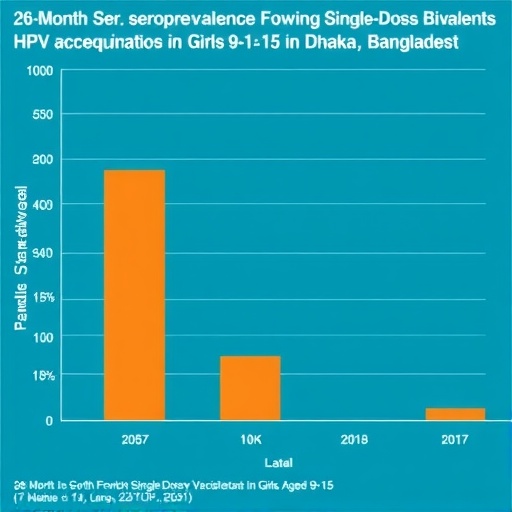In a groundbreaking study conducted in Dhaka, Bangladesh, researchers have unveiled compelling evidence highlighting the sustained immunogenicity of a single-dose bivalent human papillomavirus (HPV) vaccine among adolescent girls aged nine to fifteen years. This investigation marks a critical advancement in the fight against cervical cancer, showcasing the potential of streamlined vaccination schedules to provide enduring protection while addressing cost and logistical constraints prevalent in low-resource settings.
Human papillomavirus remains the most significant etiological agent linked to cervical cancer worldwide, with HPV types 16 and 18 being responsible for approximately 70% of cases. Vaccination strategies targeting these oncogenic strains have consequently emerged as a fundamental pillar in global cancer prevention efforts. However, the traditional multi-dose HPV vaccination regimens have posed challenges in terms of compliance, delivery, and affordability, especially in developing countries such as Bangladesh. This study, therefore, sought to evaluate the seroprevalence — a marker of vaccine-induced immunity — following administration of a single dose of the bivalent HPV vaccine in this vulnerable population.
The cross-sectional investigation enlisted 648 adolescent girls from ten local schools in Dhaka who received the single vaccine dose in November 2019. After a considerable duration of 36 months post-vaccination, researchers systematically collected and analyzed blood samples to quantify immunoglobulin G antibodies specific to HPV types 16 and 18. The analysis utilized enzyme-linked immunosorbent assay (ELISA), a sensitive and specific technique designed to detect antigen-antibody interactions, allowing precise measurement of humoral immune response. Gathering sociodemographic data concurrently enabled an intricate exploration of factors impacting vaccine efficacy.
Results from the study revealed an overall seroprevalence of 72.8% for HPV16 and 82.4% for HPV18 antigens, emphasizing the durable immunogenicity elicited by the single-dose vaccine even three years after administration. Interestingly, seropositivity for HPV16 was inversely correlated with age; older adolescent girls aged 14 to 15 exhibited significantly lower antibody prevalence compared to their younger counterparts. Similarly, students enrolled in higher grades (nine to ten) demonstrated reduced seropositivity for HPV16, suggesting a possible waning or delayed immune response influenced by maturational or environmental factors.
In contrast, seropositivity for HPV18 was notably associated with household income levels. Participants from lower-income households (monthly incomes up to Taka 10,000) demonstrated higher odds of maintaining antibody positivity against HPV18 compared with those from relatively wealthier households. This counterintuitive finding warrants further investigation, as socioeconomic status typically correlates with health outcomes and vaccine access. Potential explanations might include differential exposures, nutritional status, or yet unidentified immunomodulatory variables that influence vaccine responsiveness.
The implications of this research extend beyond the immediate context of Bangladesh, resonating with global public health strategies aimed at cervical cancer elimination. A one-dose HPV vaccination schema simplifies logistical barriers, enhances compliance, and reduces vaccine costs — factors that are instrumental in scaling up immunization in regions with limited healthcare infrastructure. Moreover, establishing robust, long-term immunity with a single dose can accelerate herd immunity, thereby diminishing the reservoir of HPV infections and subsequent cervical neoplasia.
Technically, the utilization of ELISA to detect L1-specific IgG antibodies signifies a robust surrogate marker for vaccine-induced protective immunity. The L1 protein forms the viral capsid and constitutes the primary antigenic target in bivalent vaccines. Sustained IgG levels suggest the activation of memory B cells, critical for rapid immune response upon viral exposure. However, it remains essential to differentiate between mere antibody presence and functional neutralizing activity, a nuance that future functional assays could elucidate. Such assessments would refine understanding of correlates of protection, informing vaccine policy.
The age-dependent decline in HPV16 seropositivity observed merits comprehensive immunological studies exploring mechanisms of immune senescence or hormonal modulation during adolescence. Additionally, behavioral variables including sexual activity onset, nutrition, co-infections, or environmental stressors may intertwine with immunological outcomes, demanding a multidisciplinary investigative approach. This stratified data could guide targeted booster recommendations or alternative schedules for older adolescents.
Household income’s unexpected correlation with HPV18 immunity invites sociomedical inquiries into disparities in health literacy, nutritional supplementation, or exposure to environmental adjuvants that could modulate immune responses. Alternatively, vaccine storage and administration practices across socioeconomic strata might influence antigen integrity, underscoring the importance of meticulous cold-chain management even in lower-income settings.
The study’s cross-sectional design presents inherent limitations in establishing causality, yet its large sample size, prolonged follow-up, and rigorous serological analyses render its conclusions highly credible. Longitudinal studies with serial antibody measurements and clinical endpoint assessments like HPV infection rates or cervical cytology abnormalities are needed to substantiate these promising findings further. Combining immunologic and epidemiologic data will solidify evidence supporting single-dose HPV vaccination policies.
Importantly, the study aligns with recent global dialogues advocating for simplified HPV immunization frameworks, as endorsed by the World Health Organization. Streamlining vaccine delivery could dramatically escalate coverage, especially in low- and middle-income countries, where cervical cancer morbidity and mortality remain disproportionately high. Widespread acceptance and implementation of one-dose regimens hinge on accumulating robust scientific evidence such as that provided by this investigation.
The Bangladeshi research sheds light on critical demographic and socioeconomic factors influencing vaccine-induced immunity, emphasizing the necessity for tailored public health interventions. Such nuanced understanding facilitates equitable healthcare delivery that maximizes protective benefits across heterogeneous populations. Ultimately, the convergence of scientific innovation, programmatic adaptability, and sociocultural insight will shape successful cervical cancer prevention landscapes worldwide.
In conclusion, the evidence presented supports the efficacy of a single-dose bivalent HPV vaccine in generating long-lasting antibody-mediated immunity among adolescent girls in Dhaka, Bangladesh. The nuanced associations between seropositivity, age, educational grade, and income levels underscore the complexity of vaccine responsiveness, challenging researchers and policymakers to refine HPV immunization strategies. With further validation, adopting single-dose protocols could revolutionize public health paradigms, making cervical cancer elimination an attainable global health milestone.
Subject of Research: Human papillomavirus (HPV) vaccination and immune response in adolescent girls
Article Title: Seroprevalence 36 Months after a Single-dose Bivalent Human Papillomavirus Vaccination among Nine to Fifteen-year-old Girls in Dhaka, Bangladesh: A Cross-sectional Study
News Publication Date: 13-Aug-2025
Web References:
Article DOI link: http://dx.doi.org/10.14218/CSP.2025.00008
Journal Website: https://www.xiahepublishing.com/journal/csp
Keywords: Cervical cancer, HPV vaccination, immunogenicity, seroprevalence, adolescent health, vaccine efficacy, Bangladesh, bivalent HPV vaccine, single-dose vaccination




